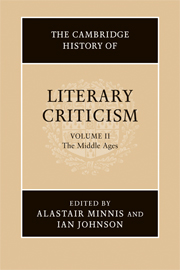Book contents
- Frontmatter
- Introduction
- I THE LIBERAL ARTS AND THE ARTS OF LATIN TEXTUALITY
- II THE STUDY OF CLASSICAL AUTHORS
- III TEXTUAL PSYCHOLOGIES: IMAGINATION, MEMORY, PLEASURE
- IV VERNACULAR CRITICAL TRADITIONS: THE EARLY MIDDLE AGES
- V VERNACULAR CRITICAL TRADITIONS: THE LATE MIDDLE AGES
- 14 Latin commentary tradition and vernacular literature
- 15 Vernacular literary consciousness c. 1100–c. 1500: French, German and English evidence
- 16 Occitan grammars and the art of troubadour poetry
- 17 Literary theory and polemic in Castile, c. 1200–c. 1500
- 18 Literary criticism in Middle High German literature
- 19 Later literary criticism in Wales
- VI LATIN AND VERNACULAR IN ITALIAN LITERARY THEORY
- VII BYZANTINE LITERARY THEORY AND CRITICISM
- Bibliography
- Index
- References
18 - Literary criticism in Middle High German literature
from V - VERNACULAR CRITICAL TRADITIONS: THE LATE MIDDLE AGES
Published online by Cambridge University Press: 28 March 2008
- Frontmatter
- Introduction
- I THE LIBERAL ARTS AND THE ARTS OF LATIN TEXTUALITY
- II THE STUDY OF CLASSICAL AUTHORS
- III TEXTUAL PSYCHOLOGIES: IMAGINATION, MEMORY, PLEASURE
- IV VERNACULAR CRITICAL TRADITIONS: THE EARLY MIDDLE AGES
- V VERNACULAR CRITICAL TRADITIONS: THE LATE MIDDLE AGES
- 14 Latin commentary tradition and vernacular literature
- 15 Vernacular literary consciousness c. 1100–c. 1500: French, German and English evidence
- 16 Occitan grammars and the art of troubadour poetry
- 17 Literary theory and polemic in Castile, c. 1200–c. 1500
- 18 Literary criticism in Middle High German literature
- 19 Later literary criticism in Wales
- VI LATIN AND VERNACULAR IN ITALIAN LITERARY THEORY
- VII BYZANTINE LITERARY THEORY AND CRITICISM
- Bibliography
- Index
- References
Summary
Among German poets of the early thirteenth century there emerges a new literary self-consciousness which manifests itself in references to the author's own person in the body of his poem and in allusions to other writers and their work.
Such references to other poets may be implicit. That is the case, for example, when the narrator in Wolfram von Eschenbach's Parzival (c. 1210) claims in 436, 4ff. that Sigune's love for the dead knight Schionatulander was such that, if the couple had been married, lady Lunete (a character in Hartmann von Aue's Iwein, c. 1200) would have been more reticent in advising Sigune to remarry than she was towards her bereaved mistress Laudine. The critical comment on the behaviour of Lunete, who presses her mistress to remarry on the very day of her husband's death, remains at the level of a playful critique of a character in another poem (as distinct, say, from being a comment on Hartmann's character motivation). By the contrast between his own characters' behaviour and that attributed to the characters of another fictional work Wolfram's narrator claims a special seriousness for the qualities of triwe (‘fidelity’) and minne (‘love’) displayed by Sigune (and later also by the hero Parzival); he marks out the divide between the values of his own literary world and those of ‘traditional’ Arthurian romance. At the same time the author establishes a relationship between the ethical constructs of his literary fiction and the real world, the world in which the composition and reception of Iwein and Parzival is to be situated.
- Type
- Chapter
- Information
- The Cambridge History of Literary Criticism , pp. 533 - 548Publisher: Cambridge University PressPrint publication year: 2005

